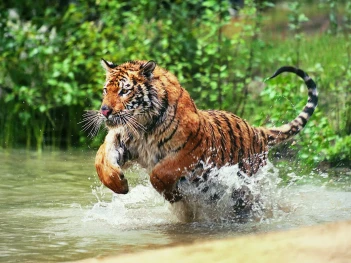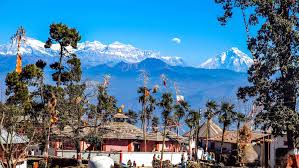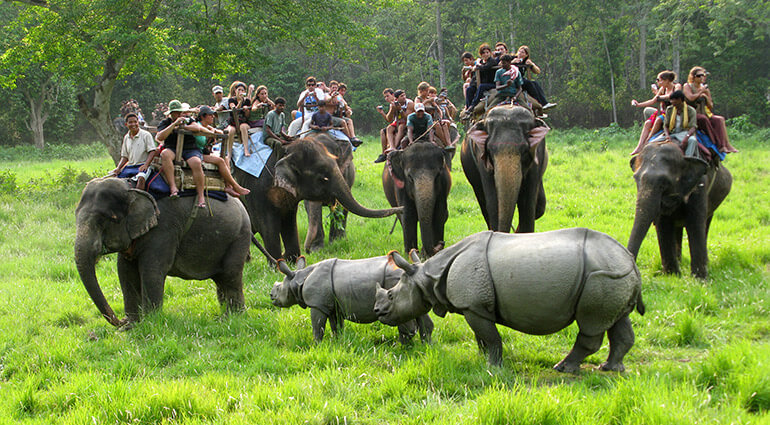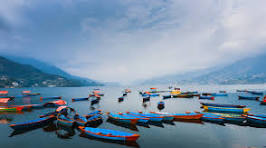Description

Pokhara is the second most visited city in Nepal, as well as one of the most popular tourist destinations. It isfamous for its tranquil atmosphere and the beautiful surrounding countryside. Pokhara lies on the shores of Phewa Lake. From Pokhara, you can see three out of the ten highest mountains in the world (Dhaulagiri, Annapurna, Manasalu). The Machhapuchre (“Fishtail”) has become the icon of the city, thanks to its pointed peak.
As the base for trekkers who make the popular Annapurna Circuit, Pokhara offers many sightseeing opportunities. Lakeside is the area of the town located on the shores of Phewa Lake, and it is full of shops and restaurants. On the south end of town, visitors can catch a boat to the historic Barahi temple, which is located on an island in the Phewa Lake.
On a hill overlooking the southern end of Phewa Lake, you will find the World Peace Stupa. From here, you can see a spectacular view of the lake, of Pokhara and Annapurna Himalayas. Sarangkot is a hill on the southern side of the lake that offers a wonderful dawn panorama, with green valleys framed by the snow-capped Annapurnas. The Seti Gandaki River has created spectacular gorges in and around the city. In places it is only a few meters wide and runs so far below that it is not visible from the top.

Chitwan National Park is the first national park in Nepal. It was established in 1973 with an area of 932sp km. Later in 1977, the park was extended to its present area of 952.63 sq km. Due to its wide biodiversity, it was listed as a World Heritage Site in 1984. Moreover, in 1997 an area of 729.37 sq km was added as a buffer zone. Before the 1950s, the forest of Chitwan spread over more than 2600 sq km was the hunting grounds for the ruling class.
This dense forest was home to about 800 one-horned rhinos. Gradually the people from the mid-hills started migrating to Chitwan in search of cultivable lands. Subsequently, the area was opened for settlement and increased human activities resulted in wildlife poaching. Furthermore, after the eradication of malaria human settlement started increasing and by the end 1960s, more than 70% of the forest was cleared. While the human population was increasing in the area rhino and other wildlife kept decreasing. To conserve the wildlife of Chitwan, the borders were marked out in December 1970. The Chitwan National Park is therefore developed with an initial area of 544 sq km
Itinerary
- Arrive in Kathmandu arrival in Kathmandu Airport, you will be greeted and assistance by our Representative. After completing your custom formalities, transfer to Hotel for check-in. Evening, attend Aarati at Pashupatinath Temple. Drive back to Hotel.
- Kathmandu - Drive to Pokhara After breakfast, drive to Pokhara (about 210 km, 6/7 hrs). En-route visit Manakamana Temple by Cable Car (Ticket extra). After puja / darshan, continue drive to Pokhara. Arrive in Pokhara. Transfer to Hotel. Overnight in hotel
- Early morning, sunrise and Himalayan view from Sarangkot hill (subject to weather condition). Next, visit Bindabasini Temple. Drive to Hotel for breakfast. Later, visit Devis fall, Gupteshwor Cave, Seti River and boat ride on Phewa Lake and visit Taal Barahi Temple. Rest of the day is free. Overnight in Pokhara HOTEL
- Pokhara - Chitwan Drive to Chitwan (about 160 km, 5 hrs drive). Arrive in Chitwan. Transfer to Hotel for check –in. Upon arrival, lunch will be served. After that, visit Tharu Village. Evening, sunset and Tharu Stick Dance. Overnight in Chitwan Hotel
- Chitwan Today, you will enjoy Jungle activities like, Elephant back safari, Elephant Breeding Center, Canoe ride on the Rapti River, Jungle Walk and Elephant bath (during summer season only). Overnight in Chitwan Hotel
- Chitwan- Kathmandu After breakfast, drive back to Kathmandu. arrival in Kathmandu, visit Swoyambhunath Stupa (Monkey Temple) if time permits. Later, transfer to Hotel for check-in. Overnight in Kathmandu Hotel
- Kathmandu - Departure Breakfast is at Hotel. Free till departure. Later, on time, transfer to International Airport for onward destination
Inclusions/Exclusions
What's Included
- PACKAGE COST INCLUDES
- Daily buffet breakfast at hotel
- Sightseeing & Transfer by Private a/c vehicle
- 3star hotel recommendation BB basis
What's Excluded
- International flight Ticket, Personal Travel Insurance, Telephone Call. Lunch and diner
- Laundry Service, Bottled drinks, Meals, your personal expenses.
- Tips for staff, guide & driver, Insurance for any loss & damage.
- Entry fees for Sightseeing of moments visit, Tour Guide, Medical free
- Jeep Safari, Any other expenses/service not mentioned in the inclusions
- Tour prices are valid for All Nationals
Similar Packages

CHITWAN TOUR
Chitwan literally means “heart of the jungle”. The popular Inner Terai valley gets its name...

SWARGADWARI TOUR
Swargadwari is a famous Hindu pilgrimage site located in the Pyuthan district in the western p...

KATHMANDU, CHITWAN , LUMBINE TOUR
Lumbini Birthplace Of Buddha Lumbini is the Buddha's birthplace, located at Rupandehi, Nepal, ...

